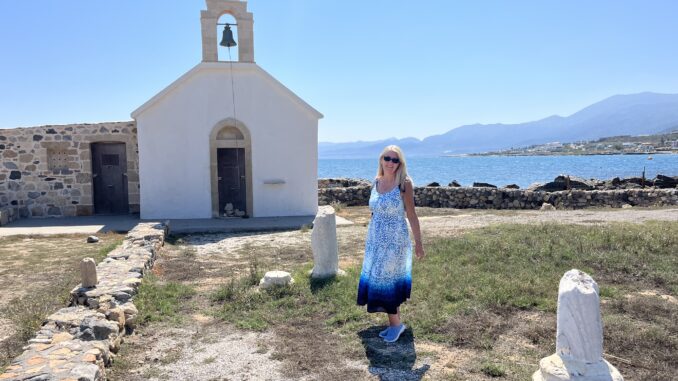
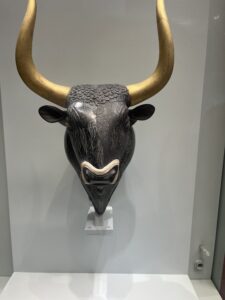
Land of the Minotaur and legendary Minoan civilisation, Crete is the largest of the Greek Islands. Perhaps lesser known as a culinary jewel glistening in the Aegean Sea but that’s exactly what Terry and I discovered as we dined our way across the island finding mouth-watering treats at every turn.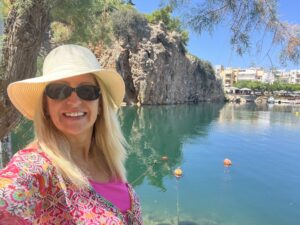
Agios Nicholas
Starting at Agios Nicholas the first feast we are greeted with is for the eyes. The town resembles a movie set overlooking glistening Lake Voulismeni where the gods Artemis and Athena purportedly bathed. The bottomless water is surrounded by charming taverns and restaurants – in the distance gigantic mountains pale into the azur sea, framing the harbour mouth and beach. Restaurant Giome Meze perches high above the town with incredible food to fit the view. Yannis, the restaurant manager, suggests we try the stuffed courgette flowers followed by sea bass, carved expertly off the bone in front of us. It is the first of many lunches where our hosts insist on finishing our meal with traditional cake washed down with Raki, a clear spirit and the most popular beverage to complete a Cretan meal.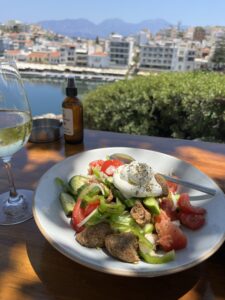
Diktaean Cave
Agios Nicholas is the capital of the Lassithi region in the east of the island. As we left the town we travelled first over mountainous terrain on skinny roads met with breathtaking views. We stopped at the prairie landscape once filled with thousands of cloth covered windmills where now only handfuls remain. High on the Lassithi Plateau is the Diktaean Cave where the Greek God Zeus was born, amongst the remarkable stalagmites and stalactites formed in the rock.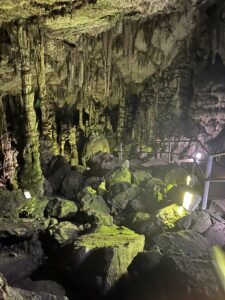 Eerie green lights and dripping water enhance the atmospheric spectacle – truly a birthplace fit for a god. The option to trek up to the cave on a donkey might make the walk easier but the vistas are so spectacular it’s a shame not to breathe in the views slowly along the way.
Eerie green lights and dripping water enhance the atmospheric spectacle – truly a birthplace fit for a god. The option to trek up to the cave on a donkey might make the walk easier but the vistas are so spectacular it’s a shame not to breathe in the views slowly along the way.
Kokolakis Olive Farm
On our next stop we find ourselves underneath the dappled shade of an olive tree with the Kokolakis family, gathered at a picnic table. I’m cupping a tiny spherical glass containing olive oil in my palm. Mikelus, the general manager at Kokolakis Olive Oil Factory is guiding us on the subtleties of the different flavours and tastes of this golden liquid.
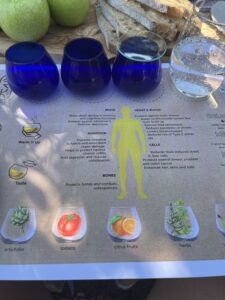 The first step in the process is to breathe the infusion in the same way as a wine. Next we take a sip and rinse around the mouth. After swallowing we wait until a burning sensation slides down the throat and we have to describe the after taste. Linked to each different variety of olive the oils omit separate aromas. I clearly get the scent of tomatoes and bananas which is not unusual after a tasting. Delicious local Kalitsouni pies are served along with the oil – this activity is a truly unique experience that I’d recommend to any foodie. Priced €50pp it is bookable online at www.kokolakisfamily.gr.
The first step in the process is to breathe the infusion in the same way as a wine. Next we take a sip and rinse around the mouth. After swallowing we wait until a burning sensation slides down the throat and we have to describe the after taste. Linked to each different variety of olive the oils omit separate aromas. I clearly get the scent of tomatoes and bananas which is not unusual after a tasting. Delicious local Kalitsouni pies are served along with the oil – this activity is a truly unique experience that I’d recommend to any foodie. Priced €50pp it is bookable online at www.kokolakisfamily.gr.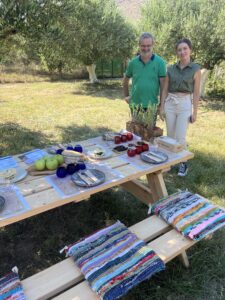
Hersonissos
Our first base is at the Mari Kristin Beach Hotel, in Hersonissos, a bustling resort that hugs the coast twenty minutes east of the capital Heraklion. It is a good base to visit the capital city and a lively resort with many bars and restaurants nestled against the cliff face. Our little balcony was positioned to watch the sun set over the beach and meandering bars and hotels.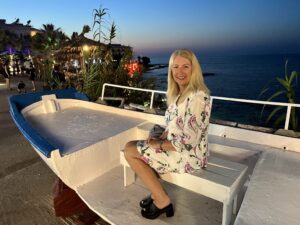 The staff couldn’t do enough for us and the location is especially good for those seeking lively nightlife. We spent two other nights at the far end of the town in the fabulous 5 star Creta Maris Resort at the quieter end of Hersonissos. Spread out with a range of apartments and bungalows it meanders like a Greek village with peaceful restaurants for adult guests while catering for the needs of families in others.
The staff couldn’t do enough for us and the location is especially good for those seeking lively nightlife. We spent two other nights at the far end of the town in the fabulous 5 star Creta Maris Resort at the quieter end of Hersonissos. Spread out with a range of apartments and bungalows it meanders like a Greek village with peaceful restaurants for adult guests while catering for the needs of families in others. 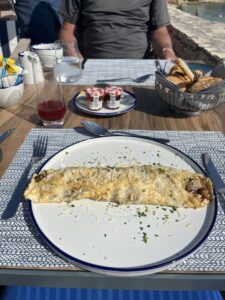 We dined at Artelis seafood restaurant beside the beach and returned for breakfast. Our wonderful suite overlooked the Cretan mountains and the roof tops down to the sea. I woke one morning and sat on the balcony hypnotised by the sun rising up over the horizon. With its own private beach it is a stunning resort and somewhere I would like to return. The hotel offers a wide range of activities too from tennis to mini golf and at night live music in some of the bars.
We dined at Artelis seafood restaurant beside the beach and returned for breakfast. Our wonderful suite overlooked the Cretan mountains and the roof tops down to the sea. I woke one morning and sat on the balcony hypnotised by the sun rising up over the horizon. With its own private beach it is a stunning resort and somewhere I would like to return. The hotel offers a wide range of activities too from tennis to mini golf and at night live music in some of the bars.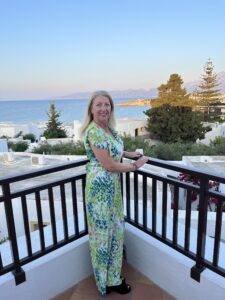
Eleftherna
Another warm welcome greets us in the west of the island when we met the director for the region, Manolis. After bringing us to see the unique pottery Keramion that can be found in the hills high above Chania he brings us to his home town of Eleftherna and serves us cheese pies to enjoy a real taste of the region. “We are completely self-sustaining here in Crete,” he informs us. 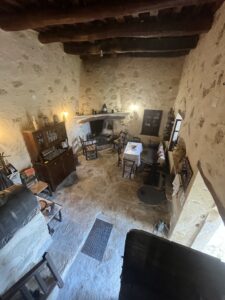 Only the day before his mother, Eleni, went out into the fields to pick wild vegetables that she used to fill our pies. He’s passionate about the restoration of the mountain cottage that his family have called home for generations. The open hearth, stone floors and corner for crushing grapes is a perfect example of typical homes in the past.
Only the day before his mother, Eleni, went out into the fields to pick wild vegetables that she used to fill our pies. He’s passionate about the restoration of the mountain cottage that his family have called home for generations. The open hearth, stone floors and corner for crushing grapes is a perfect example of typical homes in the past.
Rethymno
During the week Manolis lives in Rethymno, one of the larger towns on the northern coast and one of the most charming with a Venetian Lighthouse standing majestically at the harbour mouth. The Venetians acquired Crete from the Byzantines in 1204 and ruled for more than four centuries, leaving a fascinating range of architectural features that stand at Cretan ports.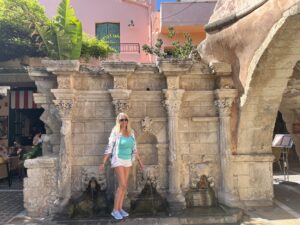 The charming Bimbondi fountain is another one of those Venetian reminders and located around the corner from Othanos restaurant where we enjoyed delicious sardines for lunch. Portion sizes are generous to say the least and Mr. Othonus has a range of impressive awards lining the walls of his delightful property. Although restaurants line the narrow cobbled streets each offers something different and fresh.
The charming Bimbondi fountain is another one of those Venetian reminders and located around the corner from Othanos restaurant where we enjoyed delicious sardines for lunch. Portion sizes are generous to say the least and Mr. Othonus has a range of impressive awards lining the walls of his delightful property. Although restaurants line the narrow cobbled streets each offers something different and fresh.
Chania
Our first night in Chania we see teams of dancers in traditional costume circling the square. The electric atmosphere runs down the main street to the waterfront. We decide to return in the daytime and try out at seafood restaurant Neoria, next to the rebuilt Minoan Ship at the Nautical Museum. 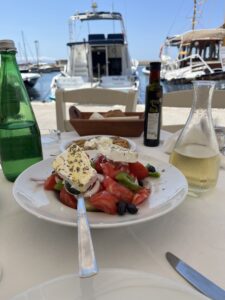 Chania is surrounded by beautiful sandy beaches that run across the west of the island. We found many lovely places to dine and soak up the stunning sunsets.
Chania is surrounded by beautiful sandy beaches that run across the west of the island. We found many lovely places to dine and soak up the stunning sunsets.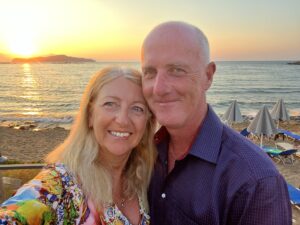
I’ll happily visit a winery for research purposes but in Crete that’s not enough on its own – there is always food involved. Dourakis Winery is a scenic drive through mountains outside Chania and a wonderful setting for lunch with all the joys of sampling wines in the process. Evie is a generous host who tells us how her father set up the winery after working in Germany in 1992 and it now produces over 200,000 bottles per year. She boasts that part of the winery’s success is the fact that it is a family business. Her father takes over as we finish sampling the rose and he brings us to the cellars to see the fruits of his labour lined up in crates and packed in bottles.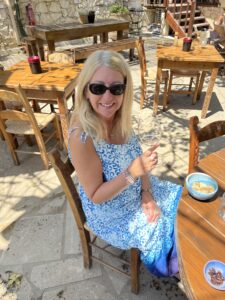
Mr Douriakis stories are engrossing as we ramble through the wide range of herbs in his garden, from lemongrass to wild mountain thyme. With his knowledge of scents it’s no wonder his wines are so well received. After the Second World War soldiers were given tea made from sage. It was used as a type of cleansing to take the evil memories of war from those who sipped it.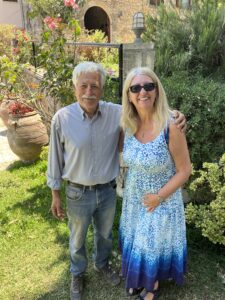 This was my first proper introduction to Cretan wine and I am already a fan. Nothing prepared us for the food that we tasted in Crete. Knowing that you are self sustaining and efficient in the way your resources are managed is a template that we all aspire to but to do it with a belly full of healthy delicious food is inspiring.
This was my first proper introduction to Cretan wine and I am already a fan. Nothing prepared us for the food that we tasted in Crete. Knowing that you are self sustaining and efficient in the way your resources are managed is a template that we all aspire to but to do it with a belly full of healthy delicious food is inspiring.
The most outstanding restaurant in Heraklion is Peskesi where the lovely Eleni Vougioukalaki brought us to sample the farm to fork fine dining that includes a remarkable fortune cookie style sugary sweet at the end of the meal. We sampled pork and shrimp cooked over flames and with an abundance of vegetables that taste good enough for a Greek Deity. As for the fortune sweet I was given a message that hinted I would be returning to Crete someday. There is a connection with the welcomes and food that sums up the Cretan spirit and their unequivocal warm hospitality so my fortune sweet heralding my return is without doubt correct.
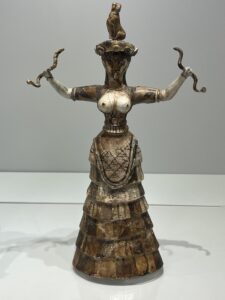
Highlight One
The Archaeological Museum in Heraklion holds many unusual and priceless artefacts. The Phiastos Disc is carved with writing that has no link to any other hieroglyphs found in the world. Also on display are two of the snake goddess from the Palace at Knossos used in various ceremonies when the Minoan culture was at its peak. 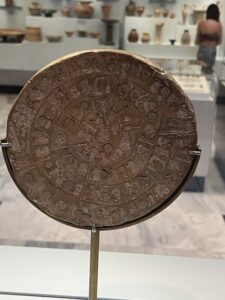 The magnificent Malia Pendant, a Minoan necklace made of gold and representing a bee is also on display and reproduced in several jewellers around the island making a lovely memento to bring home. www.heraklionmuseum.gr Take a guided tour of Knossoss Palace, only ten minutes outside the city but well worth a visit. Our guide Maria Andrianaki brought us to both.
The magnificent Malia Pendant, a Minoan necklace made of gold and representing a bee is also on display and reproduced in several jewellers around the island making a lovely memento to bring home. www.heraklionmuseum.gr Take a guided tour of Knossoss Palace, only ten minutes outside the city but well worth a visit. Our guide Maria Andrianaki brought us to both.
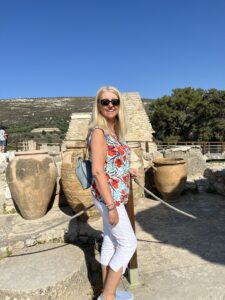
Highlight Two
Take time in Chania to explore the Maritime Museum of Crete and learn about the rich sea faring history from as far back as the Minoan Culture. See how Crete survived through the Second World War and explore the battles between the Cretans and various enemies from the Byzantine time.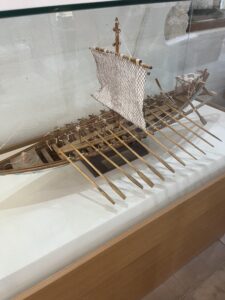 The Venetian period left a fascinating archaeological legacy and with spectacular views from the top floor you can see Chania harbour at its best www.mar-mus-crete.gr
The Venetian period left a fascinating archaeological legacy and with spectacular views from the top floor you can see Chania harbour at its best www.mar-mus-crete.gr
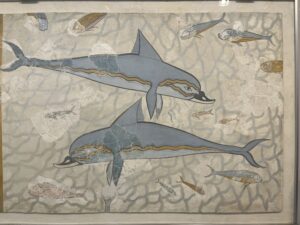
Factbox
Michelle was a guest of The Greek Tourist Board www.visitgreece.gr/ and www.incrediblecrete.gr
Enjoy Crete this September with Click and Go see www.clickandgo.com telephone -016995187
Holidays in October from just over €350pp including flights and 7 nights accommodation based on 2 sharing. Direct flights return in May call Click and Go now for more offers for summer 2024
